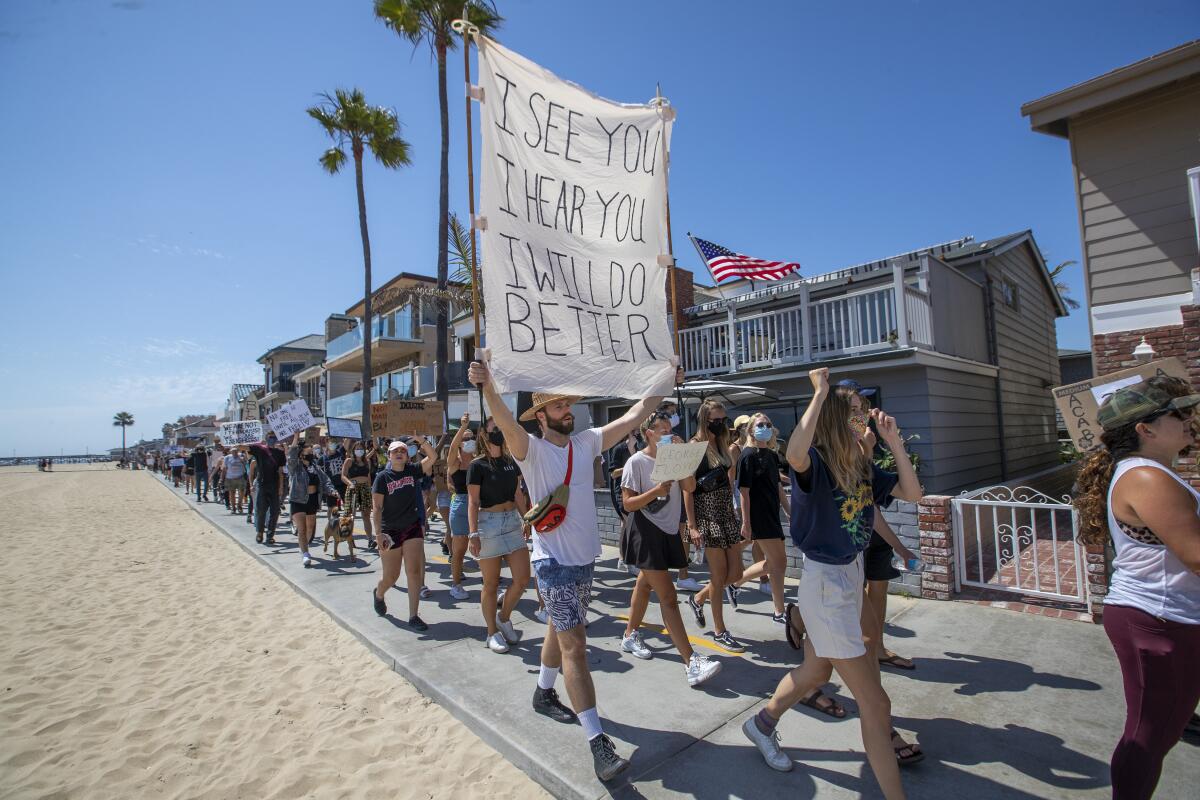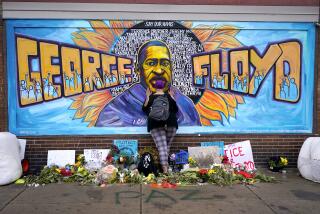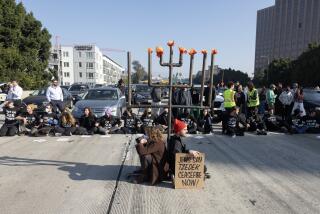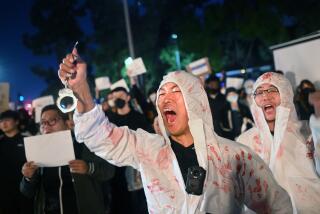‘I guess America is finally listening.’ Why George Floyd protests have spread to affluent white suburbs

- Share via
In many ways, the scene wouldn’t have looked out of place in Los Angeles, New York or other big cities across the country. Hundreds demonstrated for hours, waving homemade signs with messages such as “Silence = Violence,” chanting “No justice, no peace” and raising their fists in honor of George Floyd, a black man killed by Minneapolis police last month.
Yet this protest wasn’t happening amid downtown skyscrapers or on the steps of L.A. City Hall. Instead, the tableau was manicured medians and sidewalks outside an upscale mall a mile from the ocean in one of Southern California’s most affluent communities.
“It’s a blessing that this is going on in Newport Beach,” Gale Oliver Jr., a pastor at the Greater Light Family Church in Santa Ana, said while attending Wednesday’s demonstration. “I mean, this is going on in Newport Beach? I guess America is finally listening.”
The Orange County enclave of yachting clubs and cliffside mansions is just one example of how demonstrations in response to Floyd’s death are spreading beyond urban centers to whiter, wealthier, more conservative suburbs than prior protests against police brutality and racism.
Some of these areas have faced their own recent allegations of law enforcement mistreatment of black residents. Protests in other affluent areas, such as Beverly Hills and Santa Monica, came about because of deliberate decisions by groups including Black Lives Matter to show whiter, richer communities the pain felt by black Americans.
But a number of sociologists and pollsters said that the spontaneous demonstrations in neighborhoods that haven’t traditionally had them also reflect broader shifts in public opinion, particularly among white residents.
A majority of Americans — 57% — now believe that police officers facing a difficult or dangerous situation are more likely to use excessive force if the individual is black, according to a Monmouth University survey conducted after Floyd’s killing — a figure that’s increased from about one-third of Americans four years ago. Over that time, the percentage of white Americans who believe law enforcement is more likely to use excessive force against black people nearly doubled to just under 50%.
Patrick Murray, director of the Monmouth University Polling Institute, said the results are indicative of a “historical turning point” on views of policing.
“There has been a sea change among white Americans on how deep-rooted systemic racism is,” Murray said.
In recent days, protests against police brutality have sprung up in cities and towns across California, including communities richer and whiter than the state as a whole, such as Irvine, Walnut Creek, Danville, Redlands and Temecula.
At Wednesday’s Newport Beach event, predominantly young and white protesters packed Pacific Coast Highway, with afternoon joggers weaving their way through the crowd. Demonstrators cheered when cars — often Range Rovers, Mercedes-Benzes or Audis — rolled by and honked their horns in support.
Later, the protest shifted to the Newport Beach Pier and along a bike path in front of beachfront homes near where, less than a week earlier, on Memorial Day, kayak, boat and yacht owners launched a sailing parade in support of President Trump.
Though Orange County has long had a reputation as a conservative bastion, the last two decades have seen dramatic demographic and political change, culminating in Democratic candidates sweeping the county’s seven congressional seats in 2018 and registered Democrats overtaking Republicans last summer.
Still, Newport Beach resident Susan Groux, 52, said she’s never seen any protest like Wednesday’s in her city. The fact that demonstrations against institutional racism are spreading to areas such as hers means they’re gaining support everywhere, she said.
“Maybe this is too optimistic, but I think we’ve reached a tipping point,” said Groux, who is white. “I’ve been here since the L.A. uprising of ’92. This feels different to me. I really think there’s a change.”
Protesters in other communities were similarly taken aback by the amount of support.
The Rev. Leslie Takahashi, lead minister at the Mt. Diablo Unitarian Universalist Church in Walnut Creek, said a demonstration has taken place there almost every day since Sunday, with more planned. The city of 70,000 residents is nearly 70% white, according to U.S. census data, with median home values approaching $900,000.
“The Bay Area of course had a lot of protests for Ferguson, and there may have been a few small protests within Contra Costa County or Walnut Creek, but there was nothing like this,” said Takahashi, who has lived in the community for 13 years. “Mostly it was on the other side of the tunnel in Berkeley or Oakland.”
Takahashi said the protests have been well attended by local people, including “kids who grew up in this community, and I remember them when they were in elementary school.”
In Redlands, podcaster Anthony Boswell, 33, organized a vigil Sunday night expecting 50 mourners to show up. Instead, he said, more than 400 people came from all over the Inland Empire.
Boswell, who is black and lives in Redlands, said he had the vigil there in large part because he wanted to force people out of “their bubble.” While much less affluent and more diverse than Newport Beach or Walnut Creek, Redlands is whiter and wealthier than many surrounding areas in San Bernardino County.
“A real reason I wanted to have it in Redlands is they call themselves the jewel of the Inland Empire, they think they’re special, and a lot of the reason I wanted to do that is because if we didn’t do that, then they would have been able to continue living in their bubble and pretending these things aren’t happening,” Boswell said.
Several communities have witnessed violence and threats during the protests. Vandals broke windows, some people stole from stores and two banks were burned to the ground Saturday night in La Mesa, a San Diego suburb where that region’s first large-scale demonstrations after the Floyd killing occurred. Police in riot gear shot tear gas and projectiles at protesters, hospitalizing one 59-year-old woman who was hit between the eyes by what appeared to be a beanbag round.
Residents there were also upset about a cellphone video recording posted on social media days after Floyd’s death, showing a city police officer outside a trolley station grabbing and shoving a 23-year-old black man who police say was resisting arrest.
Walnut Creek police shot tear gas and rubber bullets and used police dogs against protesters Monday when hundreds of people rushed onto Interstate 680, stopping traffic and prompting many motorists to call 911. In Newport Beach on Wednesday, a man brandished a handgun at a demonstrator and a driver sped through a crowd of protesters, though no one was injured.
It’s not surprising that there have been clashes in communities unfamiliar with large-scale police protests, said Darnell Hunt, dean of social sciences and professor of sociology and African American studies at UCLA.
The 1965 uprising in Watts hastened the flight of white residents to suburban communities, and many outlying areas were insulated from protests and violence in South Los Angeles and other parts of the city following the 1992 acquittal of LAPD officers in the Rodney King beating, he said. Such incidents, he continued, are by definition unpredictable, and protests that may begin as peaceful can change without warning.
“There clearly is a fear of urban unrest,” said Hunt, who has written a book on the King demonstrations.
Hunt believes there are many reasons why the protests in response to Floyd’s killing have expanded so quickly and so widely. The COVID-19 pandemic has kept people in their homes for months and on edge about the health of themselves and their loved ones. It also has disproportionately affected poor black and Latino Americans. Massive unemployment in the wake of the pandemic has exacerbated anger and despair. The video of Minnesota police officer Derek Chauvin with his knee pinning Floyd by his neck for nearly nine minutes, including after he had lost consciousness, was particularly gruesome.
Hunt and Murray, the Monmouth pollster, also believe that Trump has accelerated unrest and division by not calling for unity but instead pushing for the military to quell protests. All together, these events have pushed people out into the streets despite the risks of contracting the coronavirus, Hunt said — including people who in another era might not have been stirred to action.
“You have to ask yourself when you look at the crowds that we see in the televised images coast to coast what is it that would drive people to literally risk their lives,” he said. “That really does speak to the urgency of the moment and the sense of outrage people have. That’s why we see it everywhere.”
Times staff writers Matthew Ormseth and Stephanie Lai contributed to this report.
More to Read
Sign up for Essential California
The most important California stories and recommendations in your inbox every morning.
You may occasionally receive promotional content from the Los Angeles Times.












